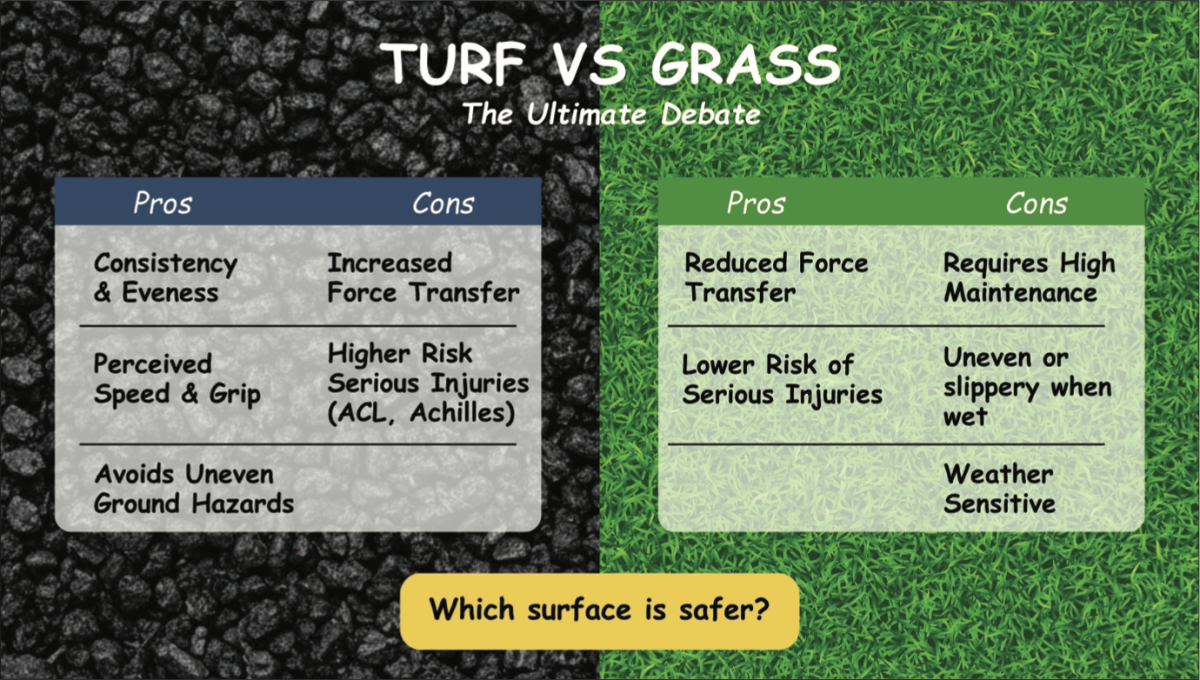
Infographic by Heli Shah
Sports have always been played on grass and there’s no reason why it should’ve changed.
It’s better to play on grass than turf because it’s a safer surface to play on with reduced injury risks.
I’ve played sports my entire life and I’ve never had a problem playing on grass, I’ve thankfully never suffered a major injury playing on the surface either.
Injuries are a part of sports, there are freak accidents that occur especially when you’re competing at a high level, but the quality of the playing surface plays a huge role.
Grass is a safer surface to play on and allows athletes to play the sport they love without increasing worries of sustaining a significant injury such as an Anterior Cruciate Ligament (ACL) or achilles tear.
For an athlete, ACL tears are a nightmare because you have to significantly limit your athletic ability until you enter the later stages of rehab and physical therapy.
The achilles is a tendon that connects the calf muscle and heel bone, when this is torn, it completely alters the movement in your leg.
You can’t walk or put any pressure on your lower leg or foot, it causes severe pain and the strength is nonexistent.
NFL players injuries were surveyed on the two surfaces during the 2021 and 2022 seasons, according to a National Library of Medicine study.
The results included the findings from different injuries with 2022 having 391 injuries reported. 161 of those injuries occurred on natural grass, but only 26 required surgery.
This is compared to 230 injuries that occurred on artificial turf and 47 of those injuries required surgeries.
There was a significant increase in injuries when players played on artificial turf and this is not a new argument as players in the NFL have voiced that they prefer to play on natural grass, according to an April 19, 2023 essay published by the NFLPA.
Injuries have occurred in the past just by simply jogging on artificial turf, NFL wide receiver Sterling Shepard tore his ACL which can be seen in a YouTube replay.
These lower extremity injuries are significant because they’re long and difficult recoveries that take up to a year, sometimes even more.
ACL tear recoveries take about six to nine months to fully recover from and achilles tears take about six to 12 months to recover from according to the Cleveland Clinic and Thetis Medical websites.
Although artificial turf may have a lighter feel and allow players to feel faster and Achilles Tendon Rupture Recovery Timeline 2025: Week-by-Week Guide (Surgical & Non-Surgical)more mobile, it’s still a high risk playing on the surface.
I’ve played on turf before and trust me, I feel a lot faster when I run and move around on turf.
But I noticed my cleats would get locked into the ground more which can be frightening, especially if you’re making a quick cut or bracing for a tackle.
I also noticed I would tend to get sore pretty often after playing on turf compared to playing and on grass.
NFL wide receiver Malik Nabers is the most recent victim of artificial turf, he tore his ACL this season against the Los Angeles Chargers on Sunday Sep. 28 just by running a route as shown in a YouTube video.
Just running on turf can cause a significant injury and MetLife stadium in New Jersey is a stadium notable for having turf that causes major injuries, Shepard and Nabers hurt themselves in that stadium.
NFL quarterback Aaron Rodgers also tore his achilles pressing off the ground during a scramble and his achilles visibly popped.
Many NFL players want stadiums to switch to natural grass and they despise playing in MetLife stadium because of the amount of significant injuries sustained there, according to a Sporting News article.
Natural grass will always be superior to artificial turf, you may “feel” like you’re playing faster and safer, but the reality is you’re more prone to significant injury which can be career altering and cause you to go through 9-12 months of rehab to return to normal athletic form.